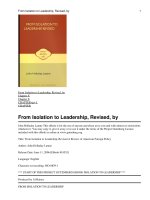leadership
Bạn đang xem bản rút gọn của tài liệu. Xem và tải ngay bản đầy đủ của tài liệu tại đây (511.8 KB, 44 trang )
ninth edition
STEPHEN P. ROBBINS
© 2007 Prentice Hall, Inc.
© 2007 Prentice Hall, Inc.
All rights reserved.
All rights reserved.
PowerPoint Presentation by Charlie Cook
PowerPoint Presentation by Charlie Cook
The University of West Alabama
The University of West Alabama
MARY COULTER
Leadership
Leadership
Chapter
Chapter
17
17
© 2007 Prentice Hall, Inc. All rights
reserved. 17–2
L E A R N I N G O U T L I N E
L E A R N I N G O U T L I N E
Follow this Learning Outline as you read and study this chapter.
Follow this Learning Outline as you read and study this chapter.
Who Are Leaders and What Is Leadership
Who Are Leaders and What Is Leadership
•
Define leaders and leadership.
Define leaders and leadership.
•
Explain why managers should be leaders.
Explain why managers should be leaders.
Early Leadership Theories
Early Leadership Theories
•
Discuss what research has shown about leadership traits.
Discuss what research has shown about leadership traits.
•
Contrast the findings of the four behavioral leadership
Contrast the findings of the four behavioral leadership
theories.
theories.
•
Explain the dual nature of a leader’s behavior.
Explain the dual nature of a leader’s behavior.
© 2007 Prentice Hall, Inc. All rights
reserved. 17–3
L E A R N I N G O U T L I N E (cont’d)
L E A R N I N G O U T L I N E (cont’d)
Follow this Learning Outline as you read and study this chapter.
Follow this Learning Outline as you read and study this chapter.
Contingency Theories of Leadership
Contingency Theories of Leadership
•
Explain how Fiedler’s theory of leadership is a
Explain how Fiedler’s theory of leadership is a
contingency model.
contingency model.
•
Contrast situational leadership theory and the leader
Contrast situational leadership theory and the leader
participation model.
participation model.
•
Discuss how path-goal theory explains leadership.
Discuss how path-goal theory explains leadership.
Contemporary Views on Leadership
Contemporary Views on Leadership
•
Differentiate between transactional and transformational
Differentiate between transactional and transformational
leaders.
leaders.
•
Describe charismatic and visionary leadership.
Describe charismatic and visionary leadership.
•
Discuss what team leadership involves.
Discuss what team leadership involves.
© 2007 Prentice Hall, Inc. All rights
reserved. 17–4
L E A R N I N G O U T L I N E (cont’d)
L E A R N I N G O U T L I N E (cont’d)
Follow this Learning Outline as you read and study this chapter.
Follow this Learning Outline as you read and study this chapter.
Leadership Issues in the Twenty-First Century
Leadership Issues in the Twenty-First Century
•
Tell the five sources of a leader’s power.
Tell the five sources of a leader’s power.
•
Discuss the issues today’s leaders face.
Discuss the issues today’s leaders face.
•
Explain why leadership is sometimes irrelevant.
Explain why leadership is sometimes irrelevant.
© 2007 Prentice Hall, Inc. All rights
reserved. 17–5
Leaders and Leadership
Leaders and Leadership
•
Leader – Someone who can influence others and who has
Leader – Someone who can influence others and who has
managerial authority
managerial authority
•
Leadership – What leaders do; the process of influencing a
Leadership – What leaders do; the process of influencing a
group to achieve goals
group to achieve goals
•
Ideally, all managers
Ideally, all managers
should be
should be
leaders
leaders
•
Although groups may have informal leaders who emerge,
Although groups may have informal leaders who emerge,
those are not the leaders we’re studying
those are not the leaders we’re studying
Leadership research has tried to answer:
Leadership research has tried to answer:
What is an effective
What is an effective
leader?
leader?
© 2007 Prentice Hall, Inc. All rights
reserved. 17–6
Early Leadership Theories
Early Leadership Theories
•
Trait Theories (1920s-30s)
Trait Theories (1920s-30s)
Research focused on identifying personal
Research focused on identifying personal
characteristics that differentiated leaders from
characteristics that differentiated leaders from
nonleaders was unsuccessful.
nonleaders was unsuccessful.
Later research on the leadership process identified
Later research on the leadership process identified
seven traits associated with successful leadership:
seven traits associated with successful leadership:
Drive, the desire to lead, honesty and integrity,
Drive, the desire to lead, honesty and integrity,
self-confidence, intelligence, job-relevant
self-confidence, intelligence, job-relevant
knowledge, and extraversion.
knowledge, and extraversion.
© 2007 Prentice Hall, Inc. All rights
reserved. 17–7
Exhibit 17–1
Exhibit 17–1
Seven Traits Associated with Leadership
Seven Traits Associated with Leadership
Source: S. A. Kirkpatrick and E. A. Locke, “Leadership: Do Traits Really Matter?” Academy of Management
Executive, May 1991, pp. 48–60; T. A. Judge, J. E. Bono, R. llies, and M. W. Gerhardt, “Personality and
Leadership: A Qualitative and Quantitative Review,” Journal of Applied Psychology, August 2002, pp. 765–780.
© 2007 Prentice Hall, Inc. All rights
reserved. 17–8
Exhibit 17–2
Exhibit 17–2
Behavioral Theories of Leadership
Behavioral Theories of Leadership
© 2007 Prentice Hall, Inc. All rights
reserved. 17–9
Exhibit 17–2 (cont’d)
Exhibit 17–2 (cont’d)
Behavioral Theories of Leadership
Behavioral Theories of Leadership
© 2007 Prentice Hall, Inc. All rights
reserved. 17–10
Early Leadership Theories (cont’d)
Early Leadership Theories (cont’d)
•
Behavioral Theories
Behavioral Theories
University of Iowa Studies (Kurt Lewin)
University of Iowa Studies (Kurt Lewin)
Identified three leadership styles:
Identified three leadership styles:
–
Autocratic style:
Autocratic style:
centralized authority, low participation
centralized authority, low participation
–
Democratic style:
Democratic style:
involvement, high participation,
involvement, high participation,
feedback
feedback
–
Laissez faire style:
Laissez faire style:
hands-off management
hands-off management
Research findings: mixed results
Research findings: mixed results
–
No specific style was consistently better for producing
No specific style was consistently better for producing
better performance
better performance
–
Employees were more satisfied under a democratic leader
Employees were more satisfied under a democratic leader
than an autocratic leader.
than an autocratic leader.
© 2007 Prentice Hall, Inc. All rights
reserved. 17–11
Early Leadership Theories (cont’d)
Early Leadership Theories (cont’d)
•
Behavioral Theories (cont’d)
Behavioral Theories (cont’d)
Ohio State Studies
Ohio State Studies
Identified two dimensions of leader behavior
Identified two dimensions of leader behavior
–
Initiating structure:
Initiating structure:
the role of the leader in defining his
the role of the leader in defining his
or her role and the roles of group members
or her role and the roles of group members
–
Consideration:
Consideration:
the leader’s mutual trust and respect for
the leader’s mutual trust and respect for
group members’ ideas and feelings.
group members’ ideas and feelings.
Research findings: mixed results
Research findings: mixed results
–
High-high leaders generally, but not always, achieved high
High-high leaders generally, but not always, achieved high
group task performance and satisfaction.
group task performance and satisfaction.
–
Evidence indicated that situational factors appeared to
Evidence indicated that situational factors appeared to
strongly influence leadership effectiveness.
strongly influence leadership effectiveness.
© 2007 Prentice Hall, Inc. All rights
reserved. 17–12
Early Leadership Theories (cont’d)
Early Leadership Theories (cont’d)
•
Behavioral Theories (cont’d)
Behavioral Theories (cont’d)
University of Michigan Studies
University of Michigan Studies
Identified two dimensions of leader behavior
Identified two dimensions of leader behavior
–
Employee oriented:
Employee oriented:
emphasizing personal relationships
emphasizing personal relationships
–
Production oriented:
Production oriented:
emphasizing task accomplishment
emphasizing task accomplishment
Research findings:
Research findings:
–
Leaders who are employee oriented are strongly
Leaders who are employee oriented are strongly
associated with high group productivity and high job
associated with high group productivity and high job
satisfaction.
satisfaction.
© 2007 Prentice Hall, Inc. All rights
reserved. 17–13
The Managerial Grid
The Managerial Grid
•
Managerial Grid
Managerial Grid
Appraises leadership styles using two dimensions:
Appraises leadership styles using two dimensions:
Concern for people
Concern for people
Concern for production
Concern for production
Places managerial styles in five categories:
Places managerial styles in five categories:
Impoverished management
Impoverished management
Task management
Task management
Middle-of-the-road management
Middle-of-the-road management
Country club management
Country club management
Team management
Team management
© 2007 Prentice Hall, Inc. All rights
reserved. 17–14
Exhibit 17–3
Exhibit 17–3
The
The
Managerial
Managerial
Grid
Grid
Source: Reprinted by permission of Harvard Business Review. An exhibit from “Breakthrough in Organization Development” by Robert R. Blake, Jane S. Mouton,
Louis B. Barnes, and Larry E. Greiner, November–December 1964, p. 136. Copyright © 1964 by the President and Fellows of Harvard College. All rights reserved.
© 2007 Prentice Hall, Inc. All rights
reserved. 17–15
Contingency Theories of Leadership
Contingency Theories of Leadership
•
The Fiedler Model (cont’d)
The Fiedler Model (cont’d)
Proposes that effective group performance depends
Proposes that effective group performance depends
upon the proper match between the leader’s style of
upon the proper match between the leader’s style of
interacting with followers and the degree to which the
interacting with followers and the degree to which the
situation allows the leader to control and influence.
situation allows the leader to control and influence.
Assumptions:
Assumptions:
A certain leadership style should be most effective
A certain leadership style should be most effective
in different types of situations.
in different types of situations.
Leaders do not readily change leadership styles.
Leaders do not readily change leadership styles.
–
Matching the leader to the situation or changing the
Matching the leader to the situation or changing the
situation to make it favorable to the leader is required.
situation to make it favorable to the leader is required.
© 2007 Prentice Hall, Inc. All rights
reserved. 17–16
Contingency Theories… (cont’d)
Contingency Theories… (cont’d)
•
The Fiedler Model (cont’d)
The Fiedler Model (cont’d)
Least-preferred co-worker (LPC) questionnaire
Least-preferred co-worker (LPC) questionnaire
Determines leadership style by measuring
Determines leadership style by measuring
responses to 18 pairs of contrasting adjectives.
responses to 18 pairs of contrasting adjectives.
–
High score: a relationship-oriented leadership
High score: a relationship-oriented leadership
style
style
–
Low score: a task-oriented leadership style
Low score: a task-oriented leadership style
Situational factors in matching leader to the situation:
Situational factors in matching leader to the situation:
Leader-member relations
Leader-member relations
Task structure
Task structure
Position power
Position power
© 2007 Prentice Hall, Inc. All rights
reserved. 17–17
Exhibit 17–4
Exhibit 17–4
Findings of the Fiedler Model
Findings of the Fiedler Model
© 2007 Prentice Hall, Inc. All rights
reserved. 17–18
Contingency Theories… (cont’d)
Contingency Theories… (cont’d)
•
Hersey and Blanchard’s Situational Leadership
Hersey and Blanchard’s Situational Leadership
Theory (SLT)
Theory (SLT)
Argues that successful leadership is achieved by
Argues that successful leadership is achieved by
selecting the right leadership style which is contingent
selecting the right leadership style which is contingent
on the level of the followers’ readiness.
on the level of the followers’ readiness.
Acceptance:
Acceptance:
leadership effectiveness depends on
leadership effectiveness depends on
whether followers accept or reject a leader.
whether followers accept or reject a leader.
Readiness:
Readiness:
the extent to which followers have the
the extent to which followers have the
ability and willingness to accomplish a specific
ability and willingness to accomplish a specific
task.
task.
Leaders must relinquish control over and contact with
Leaders must relinquish control over and contact with
followers as they become more competent.
followers as they become more competent.
© 2007 Prentice Hall, Inc. All rights
reserved. 17–19
Contingency Theories… (cont’d)
Contingency Theories… (cont’d)
•
Hersey and Blanchard’s Situational Leadership
Hersey and Blanchard’s Situational Leadership
Theory (SLT)
Theory (SLT)
Creates four specific leadership styles incorporating
Creates four specific leadership styles incorporating
Fiedler’s two leadership dimensions:
Fiedler’s two leadership dimensions:
Telling:
Telling:
high task-low relationship leadership
high task-low relationship leadership
Selling:
Selling:
high task-high relationship leadership
high task-high relationship leadership
Participating:
Participating:
low task-high relationship
low task-high relationship
leadership
leadership
Delegating:
Delegating:
low task-low relationship leadership
low task-low relationship leadership
© 2007 Prentice Hall, Inc. All rights
reserved. 17–20
Contingency Theories… (cont’d)
Contingency Theories… (cont’d)
•
Hersey and Blanchard’s Situational Leadership
Hersey and Blanchard’s Situational Leadership
Theory (SLT)
Theory (SLT)
Posits four stages follower readiness:
Posits four stages follower readiness:
R1:
R1:
followers are unable and unwilling
followers are unable and unwilling
R2:
R2:
followers are unable but willing
followers are unable but willing
R3:
R3:
followers are able but unwilling
followers are able but unwilling
R4:
R4:
followers are able and willing
followers are able and willing
© 2007 Prentice Hall, Inc. All rights
reserved. 17–21
Contingency Theories… (cont’d)
Contingency Theories… (cont’d)
•
Leader Participation Model (Vroom and Yetton)
Leader Participation Model (Vroom and Yetton)
Posits that leader behavior must be adjusted to reflect
Posits that leader behavior must be adjusted to reflect
the task structure
the task structure
—whether it is routine, nonroutine,
—whether it is routine, nonroutine,
or in between—based on a sequential set of rules
or in between—based on a sequential set of rules
(contingencies) for determining the form and amount
(contingencies) for determining the form and amount
of follower participation in decision making in a given
of follower participation in decision making in a given
situation.
situation.
© 2007 Prentice Hall, Inc. All rights
reserved. 17–22
Contingency Theories… (cont’d)
Contingency Theories… (cont’d)
•
Leader Participation Model
Leader Participation Model
Contingencies:
Contingencies:
Decision significance
Decision significance
Importance of commitment
Importance of commitment
Leader expertise
Leader expertise
Likelihood of commitment
Likelihood of commitment
Group support
Group support
Group expertise
Group expertise
Team competence
Team competence
© 2007 Prentice Hall, Inc. All rights
reserved. 17–23
Exhibit 17–5
Exhibit 17–5
Leadership Styles in the Vroom Leader Participation Model
Leadership Styles in the Vroom Leader Participation Model
•
Decide:
Decide:
Leader makes the decision alone and either announces or
Leader makes the decision alone and either announces or
sells it to group.
sells it to group.
•
Consult Individually:
Consult Individually:
Leader presents the problem to group
Leader presents the problem to group
members individually, gets their suggestions, and then makes the
members individually, gets their suggestions, and then makes the
decision.
decision.
•
Consult Group:
Consult Group:
Leader presents the problem to group members in
Leader presents the problem to group members in
a meeting, gets their suggestions, and then makes the decision.
a meeting, gets their suggestions, and then makes the decision.
•
Facilitate:
Facilitate:
Leader presents the problem to the group in a meeting
Leader presents the problem to the group in a meeting
and, acting as facilitator, defines the problem and the boundaries
and, acting as facilitator, defines the problem and the boundaries
within which a decision must be made.
within which a decision must be made.
•
Delegate:
Delegate:
Leader permits the group to make the decision within
Leader permits the group to make the decision within
prescribed limits.
prescribed limits.
Source: Based on V. Vroom, “Leadership and the Decision-Making
Process,” Organizational Dynamics, vol. 28, no. 4 (2000), p. 84.
© 2007 Prentice Hall, Inc. All rights
reserved. 17–24
Exhibit 17–6
Exhibit 17–6
Time-Driven
Time-Driven
Model
Model
Source: Adapted from V. Vroom, “Leadership and
the Decision-Making Process,” Organizational
Dynamics, vol. 28, no. 4 (2000), p. 87.
© 2007 Prentice Hall, Inc. All rights
reserved. 17–25
Contingency Theories… (cont’d)
Contingency Theories… (cont’d)
•
Path-Goal Model
Path-Goal Model
States that the leader’s job is to assist his or her
States that the leader’s job is to assist his or her
followers in attaining their goals and to provide
followers in attaining their goals and to provide
direction or support to ensure their goals are
direction or support to ensure their goals are
compatible with organizational goals.
compatible with organizational goals.
Leaders assume different leadership styles at
Leaders assume different leadership styles at
different times depending on the situation:
different times depending on the situation:
Directive leader
Directive leader
Supportive leader
Supportive leader
Participative leader
Participative leader
Achievement oriented leader
Achievement oriented leader









